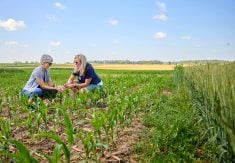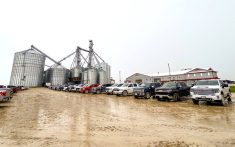The costs of seed, chemicals and fertilizer vary year to year and it can be difficult for producers to know if they are paying a fair price.
Producers can check various retailers and shop around for the best deals, but that can use up valuable time.
Why it matters: As farms grow, shaving a few cents off a unit of input has a greater impact, which is why there’s more interest in input pricing comparisons.
Producers in Ontario and Alberta have it easier than their counterparts in other provinces when it comes to finding good deals on farm inputs. Detailed information is hard to find in other parts of the country.
Read Also

Canada seventh-most influential country on agri-food
Report from Dalhousie University and MNP shows Canada ranks seventh among G20 countries on agri-food influence.
In Alberta and Ontario, producers can look at publicly available farm input surveys to get average prices for farm inputs.
In Canada, two main farm input price surveys are available: a survey from Alberta Agriculture and Forestry, and a report from the University of Guelph Ridgetown Campus called the Ontario Farm Input Monitoring Project.
The monthly Alberta Agriculture and Forestry survey was started in 1976 and collects information from up to 25 centres across Alberta on 54 farm inputs. The input list is periodically reviewed with new inputs added as needed and others dropped or modified.
Alberta Agriculture and Forestry has joined with the Alberta Federation of Agriculture (AFA) to complete the survey, using AFA representatives to collect the data each month. The data is then sorted, calculated into averages, compiled into various tables by the Alberta government and published online.
The only report similar to Alberta’s is one produced by the University of Guelph’s Ridgetown Campus. The report has been published at least three times a year, starting in 1993.
It covers 46 different inputs, such as fuel, fertilizer and pesticide prices. It sends survey enumerators to locations in Ontario and the United States, then standardizes and sorts the data and publishes the averages online.
“It provides assurances to (producers) that we do work in a North American market. Grain flows freely back and forth across the international border, between Canada/United States. So, this… ensures that the pricing here is competitive with their U.S. counterparts,” said Ken McEwan, director of the Ridgetown Campus for the U of G.
Fewer reports in the west
The Saskatchewan government carried out a farm input survey until 2002, when it was discontinued. Since then, the Agricultural Producers Association of Saskatchewan (APAS) has paid attention to the situation and last year decided to do something about it.
APAS has completed a survey of Saskatchewan producers and found that 91 per cent of respondents said they would use a farm input survey if it was available. APAS also collected a listing of different commodities producers would like to see on a survey.
APAS is now conducting a feasibility study and may apply for funding from the Canadian Agricultural Partnership. APAS is also exploring options for further research, such as partnering with a grad student or university researcher.
Several issues prompted APAS to take action on the issue, including the federal government’s funding model. Currently, Ottawa uses Alberta’s survey to determine funding for federal programs such as AgriStability, even though input costs vary from province to province.
Duane Haave, general manager of APAS, said inputs play a larger role on farms now than they did in 2002 when the Saskatchewan survey was cancelled. The group has also heard from younger producers who said they need better access to information.
“The business model wasn’t for such high use of inputs (in 2002). It wasn’t such a huge component and farms were smaller. I think when you’re looking at the size of current farm operations and the amount that they are spending in inputs, the relative risk of making money or losing money is higher,” said Haave.
The private sector steps in
Meanwhile, a new private company has set up shop on the Prairies and in Ontario offering price transparency on inputs. The American company, Farmers Business Network (FBN), expanded into Canada earlier this year. The farm management technology company offers a range of services, including a price transparency tool.
Producers who sign up can submit their farm input costs. FBN then gathers the information and disperses it anonymously among its user network, allowing producers to compare costs.
“We’re building a digital farm economy, an independent farm economy online that gives farmers, our members, much more pricing power. It gives them much more intelligence and it gives them much more access than the current industry provides,” said Charles Baron, co-founder and head of product for FBN.
FBN is a relatively young company, having launched in the U.S. in 2015. However, the company’s price transparency tools have affected the American agriculture industry. Baron said by using FBN’s data collection, it found producers can pay two to three times as much as their counterparts.
“There was no price transparency in the market (before us), meaning it was very difficult for a farmer to actually shop around for inputs,” Baron said.
While many people agree that giving producers more information is a good thing and helps level the playing field for producers, manufacturers and retailers, farmers also must make sure the data is accurate, said McEwan.
“More information is always preferred to less,” said McEwan, but he said that the information has to be accurate enough that it can actually be used to make management decisions.
Farm Credit Canada (FCC) also offers information on farm input pricing. Once a year, the crown corporation publishes an online outlook report about Canada farm input pricing. FCC uses publicly available data, such as the Alberta government’s survey.
“We want to try to add value in terms of the industry and point out trends that might not be as in your face,” said Craig Klemmer, senior agriculture economist with FCC.
The report breaks down different trends in farm input costs and then combines them with economic factors, such as the Canadian dollar’s value.
Producers can also find information on inputs from Canadian and American governments, which provide public information on farm input pricing online. Statistics Canada publishes quarterly reports for farm input costs across the country, while the U.S. Department of Agriculture (USDA) publishes regular reports.
The Statistics Canada report has been around in varying forms since 1961, however since 2011, the data has been collected from surveys done by other groups and from other Statistics Canada surveys, such as the industrial product price index and the consumer price index.
The USDA’s cost and return estimates report covers a variety of farm expenditures. The data break down the average costs for a range of expenses from chemicals to farm labour, for major U.S. crops in various agricultural areas across the country.
In Canada, other jurisdictions, besides Alberta, Saskatchewan and Ontario, have voiced interest in farm input surveys. At U of G, McEwan has heard of interest from the Maritimes, particularly among potato growers. Quebec producers have also expressed interest, he said. As well, both Manitoba and British Columbia do not have surveys and could also be interested in better access to input information.
However, Haave cautioned that pricing isn’t the only consideration. APAS found during its research that producers face other limitations when it comes to buying inputs.
“There’s certainly a distance issue. There’s a lot of travel that has to take place if you’re going to go to an alternate supplier and I think that might affect the way pricing works,” Haave said.
He added that APAS hasn’t been able to determine how much bulk purchasing affects pricing in Saskatchewan.
Still, access to the information provides a benchmark, a reference point, for producers and retailers.
In Ontario, McEwan said both retailers and producers find the survey helpful.
“The relationships I like to think that retailers have with their customers are stronger than just simply the price that we supply. So, I think (the survey) allows for good communication,” he said.















